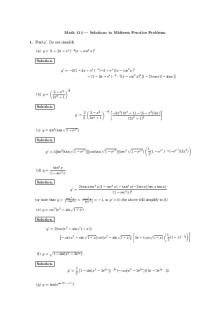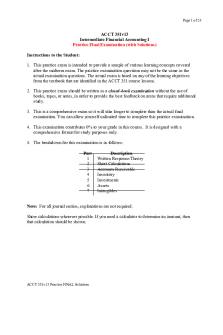Pset 10 solutions - practice PDF

| Title | Pset 10 solutions - practice |
|---|---|
| Author | Georgia Severson |
| Course | LifeSpan |
| Institution | Anna Maria College |
| Pages | 11 |
| File Size | 554.4 KB |
| File Type | |
| Total Downloads | 73 |
| Total Views | 197 |
Summary
practice...
Description
Problem 2: Radiation Pressure | Problems | 8.02 Courseware | MITx Residential
MIT: 8.02 Electricity and Magnetism
5/11/18, 1'47 PM
Help
Course ∠ PSet 11 (Due May 11) ∠ Problems ∠ Problem 2: Radiation Pressure
Discharging Capacitor A capacitor consists of two parallel circular plates of radius separated by a distance (assume ). The capacitor is initially charged to a charge . At , this capacitor begins to discharge because we insert a circular resistor of radius and height between the plates, such that the ends of the resistor make good electrical contact with the plates of the capacitor. The capacitor then discharges through this resistor for , so the charge on the capacitor becomes a function of time . Throughout this problem you may ignore edge effects.
(Part a) Use Gauss's Law to find the electric field between the plates as a function of and given parameters and . Is this electric field upward or downward?
Symbolic Check https://lms.mitx.mit.edu/courses/course-v1'MITx+8.02r_6+2018_Spri…%2B8.02r_6%2B2018_Spring%2Btype%40sequential%2Bblock%40seq-pset11
Page 1 of 5
Problem 2: Radiation Pressure | Problems | 8.02 Courseware | MITx Residential
5/11/18, 1'47 PM
For the symbolic check, write your answer using some or all of the following: Q for and epsilon_0 for . No check is provided for the direction.
, ,
Answer: Q/(pi*a^2*epsilon_0) Solution: (Part a)
The direction is upward, from the positive plate to the negative plate. (Part b) For unit normal
, consider an open surface of radius upward (see figure).
inside the capacitor with its
For , what is the current flowing through this open surface? Define the direction of positive current to be upward, and be careful about signs.
Symbolic Check
https://lms.mitx.mit.edu/courses/course-v1'MITx+8.02r_6+2018_Spri…%2B8.02r_6%2B2018_Spring%2Btype%40sequential%2Bblock%40seq-pset11
Page 2 of 5
Problem 2: Radiation Pressure | Problems | 8.02 Courseware | MITx Residential
5/11/18, 1'47 PM
For the symbolic check, write your answer using some or all of the following: Q for and epsilon_0 for . Enter the ratio .
, ,
Answer: -r^2/a^2 Solution: (Part b) The current flowing through this surface is
and is pointing upward. Note that .
, so for a discharging capacitor
(Part c) For this same open surface, what is the time rate of change of the electric flux though the surface? (Hint: use your answer above for
).
Symbolic Check For the symbolic check, write your answer using some or all of the following: Q for and epsilon_0 for . Enter the ratio .
, ,
Answer: 1/epsilon_0*r^2/a^2 Solution: (Part c) The electric flux through the surface of radius
is
https://lms.mitx.mit.edu/courses/course-v1'MITx+8.02r_6+2018_Spri…%2B8.02r_6%2B2018_Spring%2Btype%40sequential%2Bblock%40seq-pset11
Page 3 of 5
Problem 2: Radiation Pressure | Problems | 8.02 Courseware | MITx Residential
5/11/18, 1'47 PM
Therefore, the time rate of change of electric flux is
(Part d) What is the integral of the magnetic field around the contour bounding this open circle, using the Ampere-Maxwell Law? Be careful of signs.
Symbolic Check For the symbolic check, write your answer using some or all of the following: Q for , mu_0 for
and epsilon_0 for
. Enter the ratio
, ,
.
Answer: 0 Solution: (Part d)
Although the answer may seem surprising, the contributions to the magnetic field from the charges moving between the plates exactly cancels the contribution from the decreasing electric flux. https://lms.mitx.mit.edu/courses/course-v1'MITx+8.02r_6+2018_Spri…%2B8.02r_6%2B2018_Spring%2Btype%40sequential%2Bblock%40seq-pset11
Page 4 of 5
Problem 2: Radiation Pressure | Problems | 8.02 Courseware | MITx Residential
"
5/11/18, 1'47 PM
Answers are displayed within the problem
© All Rights Reserved
https://lms.mitx.mit.edu/courses/course-v1'MITx+8.02r_6+2018_Spri…%2B8.02r_6%2B2018_Spring%2Btype%40sequential%2Bblock%40seq-pset11
Page 5 of 5
MIT: 8.02 Discover New
MIT 8.02: Electricity and Magnetism Course
Canvas
Piazza
Progress
Course " PSet 10 (Due Dec 4) " Pset 10 " Superposition of Two Travelling Waves
& Previous
%
%
%
Superposition of Two Travelling Waves # # Bookmark this page
Superposition of Two Travelling Waves 0 points possible (ungraded) Suppose the electric !eld of an electromagnetic wave is given by the superposition of two w
𝐄 = 𝐸0 cos (𝑘𝑧 − 𝜔𝑡) 𝐢 + 𝐸0 cos (𝑘𝑧 + 𝜔𝑡) 𝐢
(a) What is the associated magnetic !eld 𝐁 (𝑧, 𝑡)? Please express your answer using x, y, z, t, hatj, and hatk for the unit vectors 𝑖 , 𝑗 and 𝑘, respectively.
𝐁 =
E_0/c*cos(k*z-omega*t)*hatj - E_0/c*cos(k*z+omega*t)*hatj
$
Answer: E_0 / c * (cos(k*z - omega * t) - cos(k * z + omega * t)) * hatj
𝐸0 𝐸0 ⋅ cos (𝑘 ⋅ 𝑧 − 𝜔 ⋅ 𝑡) ⋅ 𝑗 − ⋅ cos (𝑘 ⋅ 𝑧 + 𝜔 ⋅ 𝑡) ⋅ 𝑗 𝑐 𝑐 Solution: Treat each plane wave separately. The amplitude of the magnetic !eld is 𝐸0/𝑐. Recall that th direction of propagation of the wave. Consider the !rst term in the electric !eld 𝐸0 cos (𝑘𝑧
is (𝐸0 /𝑐) cos (𝑘𝑧 − 𝜔𝑡)𝐣 . Note that ( 𝐄 × 𝐁) is in the positive 𝐤-direction, which is the directio indicated by the “ 𝑧" in the !rst term of (𝑘𝑧 − 𝜔𝑡) and the positive direction indicated by the terms. For the plane wave 𝐸0 cos (𝑘𝑧 + 𝜔𝑡)𝐢 , which is traveling in the negative 𝐤-direction, the asso − ( 𝐸0/𝑐) cos (𝑘𝑧 + 𝜔𝑡) 𝐣. Again note that 𝐄 × 𝐁 = − (𝐸02/𝑐) cos2 (𝑘𝑧 + 𝜔𝑡) 𝐤 , which is pointing Therefore the magnetic !eld is the sum of these two contributions:
𝐸0 𝐁 (𝑧, 𝑡) = (cos (𝑘𝑧 − 𝜔𝑡) − cos (𝑘𝑧 + 𝜔𝑡)) 𝐣 . 𝑐 (b) Use the trigonometry identities cos (𝑘𝑧 ± 𝜔𝑡) = cos (𝑘𝑧) cos (𝜔𝑡) ∓ sin (𝑘𝑧) sin (𝜔𝑡), cos ( to show that you can write the electric and magnetic !eld as
𝐄 (𝑧, 𝑡) = 2𝐸 0 cos (𝑘𝑧) cos (𝜔𝑡) 𝐢 2𝐸0 sin (𝑘𝑧) sin (𝜔𝑡) 𝐣 𝐁 (𝑧, 𝑡) = 𝑐 There is no answer check for this question. Solution: Using the above identity, we can rewrite the electric !eld as
𝐄 (𝑧, 𝑡) = 𝐸0 (cos (𝑘𝑧 − 𝜔𝑡) + cos (𝑘𝑧 + 𝜔𝑡)) 𝐢 = 𝐸0 (cos (𝑘𝑧) cos (−𝜔𝑡) − sin (𝑘𝑧) sin (−𝜔𝑡) + cos (𝑘𝑧) cos (𝜔𝑡) − sin = 𝐸0 (cos (𝑘𝑧) cos (𝜔𝑡) + sin (𝑘𝑧) sin (𝜔𝑡) + cos (𝑘𝑧) cos (𝜔𝑡) − sin (𝑘𝑧 = 2 𝐸0 cos (𝑘𝑧) cos (𝜔𝑡) 𝐢
We can rewrite the magnetic !eld as
𝐸0 (cos (𝑘𝑧 − 𝜔𝑡) − cos (𝑘𝑧 + 𝜔𝑡)) 𝐣 𝑐 𝐸0 = (cos (𝑘𝑧) cos (−𝜔𝑡) − sin (𝑘𝑧) sin (−𝜔𝑡) − (cos (𝑘𝑧) cos (𝜔𝑡) − sin 𝑐 𝐸0 = (cos (𝑘𝑧) cos (𝜔𝑡) + sin (𝑘𝑧) sin (𝜔𝑡) cos (𝑘𝑧) cos (𝜔𝑡) + sin (𝑘𝑧
𝐁 (𝑧, 𝑡) =
| Problems | 8.02 Courseware | MITx Residential
5/11/18, 2(59 PM
MIT: 8.02 Electricity and Magnetism
Help
Course ∠ PSet 11 (Due May 11) ∠ Problems ∠
Electromagnetic Plane Wave An electromagnetic plane wave is propagating in vacuum, and has a magnetic field given by:
(1)
where
and
are positive quantities. The
direction is out of the paper.
(Part a) What condition between equations?
and
must be met in order for this wave to satisfy Maxesll's
Please solve this condition for , and express
using some or all of the b,c,B_0 for
.
Answer: b/c Solution:
Differentiating
with respect to
gives:
https://lms.mitx.mit.edu/courses/course-v1(MITx+8.02r_6+2018_Spri…%2B8.02r_6%2B2018_Spring%2Btype%40sequential%2Bblock%40seq-pset11
Page 1 of 4
| Problems | 8.02 Courseware | MITx Residential
5/11/18, 2(59 PM
Thus,
Because
and
are positive quantities, in order for the equation to be satisfied, we need:
(Part b) What is the magnitude and direction of the
field of this wave?
Write magnitude times direction: e.g. "E_0 * (-hati)". Express your answer using some or all of the b,c,B_0 for , mu_0 for ; hati, hatj, hatk for unit vectors.
Answer: c* B_0 * hatk Solution:
The electromagnetic wave propagates in the -direction with the field pointing in the -direction. Since the direction of propagation is along the direction of the corss product , the electric field must point in the
-direction.
(Part c)
https://lms.mitx.mit.edu/courses/course-v1(MITx+8.02r_6+2018_Spri…%2B8.02r_6%2B2018_Spring%2Btype%40sequential%2Bblock%40seq-pset11
Page 2 of 4
| Problems | 8.02 Courseware | MITx Residential
5/11/18, 2(59 PM
What is the magnitude and direction of the energy flux (power per unit area). Express your answer using some or all of the b,c,B_0 for , mu_0 for ; hati, hatj, hatk for unit vectors. Write magnitude times direction: e.g. "E_0 * (-hati)".
Answer: (c* B_0^2 / mu_0) * (-hati) Solution:
Because
And
, the magnitude of the Poynting vector is:
points in the direction of propagation (
-direction).
(Part d) This wave hits a perfectly conducting sheet, and is reflected. What is the pressure (force per unit area) that this wave exerts on the sheet while it is impinging on it? Express your answer using some or all of the b,c,B_0 for
, mu_0 for
.
Answer: 2* B_0^2 / mu_0 Solution:
With total reflection, the time-averaged pressure exerted by the wave on a perfectly conducting sheet is:
https://lms.mitx.mit.edu/courses/course-v1(MITx+8.02r_6+2018_Spri…%2B8.02r_6%2B2018_Spring%2Btype%40sequential%2Bblock%40seq-pset11
Page 3 of 4
| Problems | 8.02 Courseware | MITx Residential
5/11/18, 2(59 PM
" Answers are displayed within the problem
© All Rights Reserved
https://lms.mitx.mit.edu/courses/course-v1(MITx+8.02r_6+2018_Spri…%2B8.02r_6%2B2018_Spring%2Btype%40sequential%2Bblock%40seq-pset11
Page 4 of 4
MT: 8.02
MT 8.02: Eecc ad Mage
H
Dc N
C ą W 15 (Dc 7-11) ą Fa R Pb ą Sa EM Wa
Sda EM Wae Sa Pa Ecac Wa 0 b (a)
ab, a
, ac a a cac a a a
a a a -c.
T cc a b
1.
2.
3.
4.
5.
6.
7.
8.
Solution: G a ac a
, a cc b
a a a -c, a c b T c
, a a a aa c (
a aa c cc b Cb a ab a cc 1.
) ac
, c
bca
c
Ú...
Similar Free PDFs

Pset 10 solutions - practice
- 11 Pages

PSET 3
- 4 Pages

Solutions 10
- 12 Pages

Practice Solutions
- 71 Pages

Hw5 pset - hw 5
- 2 Pages

Midterm Practice 1 Solutions
- 9 Pages

Bond practice solutions udpated
- 16 Pages

Practice Test 1 - Solutions
- 21 Pages

Practice 1 - Solutions - Seminar
- 5 Pages

Practice Final solutions
- 24 Pages

All Practice Set Solutions
- 21 Pages
Popular Institutions
- Tinajero National High School - Annex
- Politeknik Caltex Riau
- Yokohama City University
- SGT University
- University of Al-Qadisiyah
- Divine Word College of Vigan
- Techniek College Rotterdam
- Universidade de Santiago
- Universiti Teknologi MARA Cawangan Johor Kampus Pasir Gudang
- Poltekkes Kemenkes Yogyakarta
- Baguio City National High School
- Colegio san marcos
- preparatoria uno
- Centro de Bachillerato Tecnológico Industrial y de Servicios No. 107
- Dalian Maritime University
- Quang Trung Secondary School
- Colegio Tecnológico en Informática
- Corporación Regional de Educación Superior
- Grupo CEDVA
- Dar Al Uloom University
- Centro de Estudios Preuniversitarios de la Universidad Nacional de Ingeniería
- 上智大学
- Aakash International School, Nuna Majara
- San Felipe Neri Catholic School
- Kang Chiao International School - New Taipei City
- Misamis Occidental National High School
- Institución Educativa Escuela Normal Juan Ladrilleros
- Kolehiyo ng Pantukan
- Batanes State College
- Instituto Continental
- Sekolah Menengah Kejuruan Kesehatan Kaltara (Tarakan)
- Colegio de La Inmaculada Concepcion - Cebu




